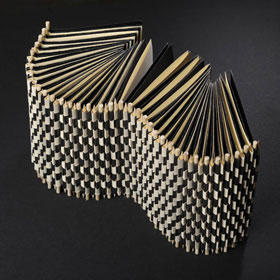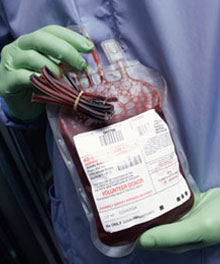UAB Magazine Online Features
Intellectual Firepower
UAB Accounting Graduate Turns IRS Investigator
By Caperton Gillett
Assuming you haven’t recently attempted to defraud the government, you probably would enjoy meeting Donald Smith. The 2006 UAB accounting graduate is a special agent in the Birmingham office of the Internal Revenue Service’s Criminal Investigation Division (CID). But the popular image of the IRS agent in short-sleeved shirt and Coke-bottle glasses, “collecting taxes and maybe harassing a few people,” as Smith says, doesn’t fit this unfailingly polite—and well-dressed—guy.
 |
He may not fit the stereotypes of an IRS agent or a CPA, but Donald Smith uses his accounting degree from UAB to track down money launderers and drug traffickers through his role as an agent in the IRS's Criminal Investigation Division. |
His job description isn’t exactly in line with conventional wisdom, either. Although Smith says he draws on his UAB accounting training daily, he spends more time out in the field than hunched over a calculator. And when push comes to shove, he can deploy something more effective than intellectual firepower: a .40 caliber Glock handgun.
By the Books
The role of the CID, Smith explains, is to apprehend and prosecute criminals who commit financial fraud. That means he spends much of his time soliciting testimony from witnesses and victims of fraud. “Particularly with victims, I tell them, ‘I’m here as a friend to help you out. All I need is for you to tell me what happened to cause you this kind of distress.’ I try to come across as the nice guy from the IRS.” When he is dealing with criminals—including drug traffickers and money launderers—a different persona emerges, however. “I always talk to people with the utmost respect, but my job is to gather evidence.”
The Sound of Change
High-Tech Hearing Aids Put Seniors Back in the Conversation
By Dorothy Foltz-Gray
 |
Audiologist Cara Snable says that advances in technology have made modern hearing aids virtually undetectable—and have vastly improved sound quality. |
Five years ago, Ida, 68, a widow in Fort Payne, Alabama, began noticing she had to work hard to follow conversations. The pleasure of discussion had become a chore. “I knew someone was speaking, but I was missing words,” she says. “When I couldn’t hear my grandchildren, that motivated me to do something.” At UAB’s Kirklin Clinic, audiologist Cara Snable fitted Ida with tiny hearing units on each ear that have made a big difference in her quality of life.
New audio technologies have shrunk hearing aids to the point that they’re almost undetectable, while sound quality has improved tremendously, Snable says. And that’s good news for the estimated 20 to 40 percent of older adults with some sort of hearing impairment, notes UAB geriatrician Andrew Duxbury, M.D., a professor in the Division of Gerontology, Geriatrics, and Palliative Care.
It’s important to keep in mind that hearing well isn’t a perk—it’s a health necessity, Duxbury says. A person with hearing loss may not detect oncoming traffic as he or she crosses a road, for example. “When people feel less safe, they shrink their world,” says Duxbury. “They stop driving and socializing. If you cannot hear properly, you become isolated from what is going on in the world, from your family, and from your peer group.”
Cover Models
UAB Students Reimagine the Book
By Charles Buchanan
It seems that you can judge a book by its cover—if it’s one of the fanciful tomes created by students in UAB’s book arts course. You’re more likely to find these books in a gallery than on a bestseller list, however, because each volume is designed to be a unique work of art.
 |
Students in UAB's book arts program create their own unique works from scratch, combining centuries-old techniques with cutting-edge designs. The work above was created by Brooke Lancaster. |
“These pieces use the format of the book as an avenue for creative expression,” explains Doug Baulos, assistant professor of drawing and bookmaking in the UAB Department of Art and Art History. Each book’s structure, binding, paper, and printing are part of the art. “Content is not limited to words alone,” says Baulos, and in fact, some of the books contain no words at all.
Creating a book from scratch—and by hand—is a time-honored tradition. Centuries ago, it was the only way to make a book. Today, Baulos says, students from a variety of majors are eager to experiment with the techniques and materials that are part of the process. They also enjoy the challenge of seeing the book as an art form. “Sculpture students, for example, use the class to explore narrative, mass, and the book as object,” Baulos adds. “Graphic design majors use it as a professional practice course for layout, production, and so forth.”
(Story continues below slideshow)
The Life of Blood
New Truths About Transfusions
By Tara Hulen
 |
Blood transfusions are a vital part of modern medicine, but recent research shows that patients who receive fewer transfusions often fare better. These findings have spurred changes in the way blood is used at UAB Hospital. |
Blood is known as the “gift of life,” but the present isn’t as welcome as scientists once thought. Research over the past decade has revealed that patients fare better when blood transfusions are kept to a minimum, a realization that has brought major changes in the way UAB and other medical centers across the country handle their blood.
When a patient gets a transfusion—to replace blood lost during surgery or after a car accident, for example—the blood the patient receives isn’t the same as the blood flowing through that patient’s own body, even if it’s the same blood type, says Marisa B. Marques, M.D., director of the Transfusion Service at UAB and co-chair of the UAB Blood Utilization and Management Committee. That is where the problems start.
Blood Simple
The fluid we call blood actually includes many components, including red blood cells (which carry oxygen), plasma (the liquid portion that carries the red blood cells), and platelets (cell fragments that, among other things, cause blood to clot). Blood donated to the American Red Cross and other collection organizations is separated into these three components for storage. Each has its own use in a blood transfusion.
Because the original plasma that surrounded the red blood cells has been removed, “the red cells are re-suspended in a fluid to keep them ‘alive,’” Marques says. “What is becoming more and more clear is that as these cells sit in a bag in a blood bank for up to six weeks, a lot of things are happening inside.”
